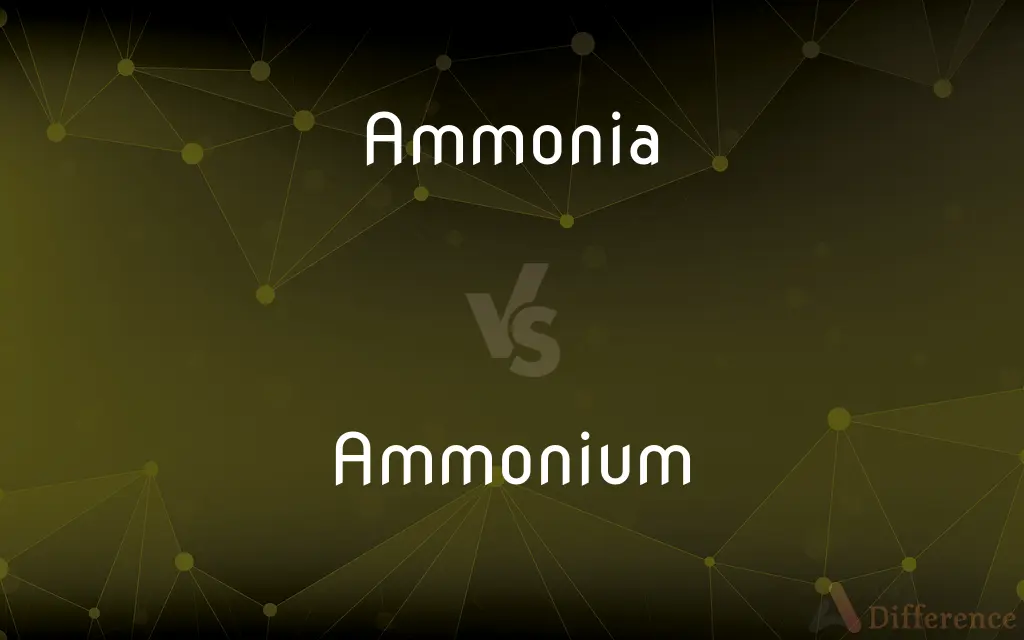Ammonia vs. Ammonium — What's the Difference?
Edited by Tayyaba Rehman — By Fiza Rafique — Updated on September 25, 2023
Ammonia is a pungent gas (NH₃), while ammonium (NH₄⁺) is its positively charged ion, often found in salts.

Difference Between Ammonia and Ammonium
Table of Contents
ADVERTISEMENT
Key Differences
Ammonia, with the chemical formula NH₃, is a compound composed of nitrogen and hydrogen. Ammonium, on the other hand, is the ionic form of ammonia, represented as NH₄⁺, and often occurs when ammonia accepts a proton (H⁺).
While ammonia is a colorless and pungent gas, it can be dissolved in water to form a weak base. When dissolved, some of the ammonia molecules combine with water's H⁺ ions to form ammonium ions. Both ammonia and ammonium can coexist in equilibrium in an aqueous solution.
Ammonia is often used industrially in the production of fertilizers, plastics, and other chemicals. Ammonium, as an ion, often pairs with negatively charged ions (anions) to form various salts, like ammonium chloride (NH₄Cl) or ammonium nitrate (NH₄NO₃).
In environmental contexts, ammonia is a compound that can be found in the atmosphere, soil, or water. It can originate from natural processes or human activities. Ammonium, being a cation, is typically present in soil or aquatic systems, where it can be taken up by plants as a nutrient source.
Comparison Chart
Chemical Formula
NH₃
NH₄⁺
ADVERTISEMENT
State
Gas at room temperature.
Ion, often found in salts.
Charge
Neutral.
Positively charged.
Production/Formation
Natural process or industrial synthesis.
Formed when ammonia accepts a proton.
Uses
Fertilizers, cleaning, refrigeration.
Present in fertilizers, salts, solutions
Compare with Definitions
Ammonia
Ammonia consists of nitrogen and hydrogen atoms.
The molecular structure of ammonia is one nitrogen atom bonded to three hydrogen atoms.
Ammonium
Ammonium is the ionic form of ammonia.
Ammonium ions form when ammonia reacts with water.
Ammonia
Ammonia can act as a weak base in solutions.
When ammonia is dissolved in water, it increases the solution's pH.
Ammonium
Ammonium salts are common and have various applications.
Ammonium nitrate is a popular fertilizer.
Ammonia
Ammonia can be harmful in large concentrations.
Prolonged exposure to high levels of ammonia can be detrimental to health.
Ammonium
Ammonium can be found in several natural environments.
Soil often contains ammonium, which plants use as a nutrient.
Ammonia
Ammonia is a colorless gas with a pungent smell.
The smell of ammonia was evident in the cleaning solution.
Ammonium
Ammonium's presence affects the acidity of solutions.
A high concentration of ammonium ions can make a solution more acidic.
Ammonia
Ammonia is used in many industrial processes.
Many fertilizers are synthesized using ammonia.
Ammonium
Ammonium has a positive charge.
The chemical representation of ammonium is NH₄⁺.
Ammonia
Ammonia is a compound of nitrogen and hydrogen with the formula NH3. A stable binary hydride, and the simplest pnictogen hydride, ammonia is a colourless gas with a distinct characteristic of a pungent smell.
Ammonium
The ammonium cation is a positively charged polyatomic ion with the chemical formula NH+4. It is formed by the protonation of ammonia (NH3).
Ammonia
A colourless gas with a characteristic pungent smell, which dissolves in water to give a strongly alkaline solution.
Ammonium
The univalent chemical ion NH4+, derived from ammonia, whose compounds chemically resemble the alkali metals.
Ammonia
A colorless, pungent gas, NH3, extensively used to manufacture fertilizers and a wide variety of nitrogen-containing organic and inorganic chemicals. Ammonia is the chief nitrogen product excreted by fish and other aquatic animals.
Ammonium
(inorganic chemistry) The univalent NH4+ cation, derived by the protonation of ammonia
Ammonia
See ammonium hydroxide.
Ammonium
Any similar cation formed by replacing one or more hydrogen atoms with alkyl or aryl radicals
Ammonia
(inorganic compound) A gaseous compound of hydrogen and nitrogen, NH3, with a pungent smell and taste.
Ammonium
A compound radical, NH4, having the chemical relations of a strongly basic element like the alkali metals.
Ammonia
A solution of this compound in water used domestically as a cleaning fluid.
Never use ammonia to clean metal writing pens.
Ammonium
The ion NH4 derived from ammonia; behaves in many respects like an alkali metal ion
Ammonia
A gaseous compound of hydrogen and nitrogen, NH3, with a pungent smell and taste: - often called volatile alkali, and spirits of hartshorn.
Ammonia
A pungent gas compounded of nitrogen and hydrogen (NH3)
Ammonia
A water solution of ammonia
Common Curiosities
Is ammonia harmful to humans?
Yes, in high concentrations, ammonia is toxic and can irritate the lungs and eyes.
Are ammonium salts acidic or basic?
Ammonium salts are typically acidic when dissolved in water.
Is ammonia a gas or liquid at room temperature?
Ammonia is a gas at room temperature.
What's the relationship between ammonia and ammonium in water?
In water, ammonia can accept a proton to become ammonium.
Is it safe to mix ammonia with other household chemicals?
No, mixing ammonia with certain chemicals, like bleach, can produce toxic gases.
What are the environmental impacts of ammonia?
Ammonia can lead to eutrophication in water bodies and contribute to particulate pollution in the air.
Can you find ammonium in household items?
Yes, ammonium salts are often in cleaning products and fertilizers.
What happens when ammonia is dissolved in water?
It forms an equilibrium with ammonium and hydroxide ions.
Can ammonium ions be found in the atmosphere?
Ammonium ions are typically found in particulate matter in the atmosphere, not as free ions.
Are ammonium ions beneficial for plants?
Yes, plants can uptake ammonium as a source of nitrogen.
Why do some cleaning products contain ammonia?
Ammonia's properties make it effective in breaking down grime and grease.
How can one differentiate between solutions of ammonia and ammonium?
A pH test can help; ammonia solutions are basic, while ammonium solutions are often acidic.
How is ammonia produced industrially?
The Haber-Bosch process is a primary method to synthetically produce ammonia.
Is ammonium present in rainwater?
Yes, ammonium can be found in rainwater due to atmospheric reactions and deposition.
Are ammonia and ammonium the same in terms of smell?
No, ammonia has a pungent smell, while ammonium salts might not have the same strong odor.
Share Your Discovery

Previous Comparison
Tottari vs. Hikiotoshi
Next Comparison
Rotate vs. RollAuthor Spotlight
Written by
Fiza RafiqueFiza Rafique is a skilled content writer at AskDifference.com, where she meticulously refines and enhances written pieces. Drawing from her vast editorial expertise, Fiza ensures clarity, accuracy, and precision in every article. Passionate about language, she continually seeks to elevate the quality of content for readers worldwide.
Edited by
Tayyaba RehmanTayyaba Rehman is a distinguished writer, currently serving as a primary contributor to askdifference.com. As a researcher in semantics and etymology, Tayyaba's passion for the complexity of languages and their distinctions has found a perfect home on the platform. Tayyaba delves into the intricacies of language, distinguishing between commonly confused words and phrases, thereby providing clarity for readers worldwide.














































